Enhancing the Photocatalytic Performance of WO3/AgBr Composites Through the Incorporation of Olive Waste-Derived Biochar Obtained Under Controlled Pyrolysis Conditions
Abstract
1. Introduction
2. Results and Discussion
2.1. Characterization of the Materials
2.1.1. Biochar
2.1.2. Photocatalysts/Biochar Systems
2.2. Photocatalytic Runs
3. Materials and Methods
4. Conclusions
Supplementary Materials
Author Contributions
Funding
Institutional Review Board Statement
Informed Consent Statement
Data Availability Statement
Acknowledgments
Conflicts of Interest
References
- Lee, D.E.; Kim, M.K.; Danish, M.; Jo, K. State-of-the-art review on photocatalysis for efficient wastewater treatment: Attractive approach in photocatalyst design and parameters affecting the photocatalytic degradation. Catal. Commun. 2023, 183, 106764. [Google Scholar] [CrossRef]
- Ran, B.; Ran, L.; Wang, Z.; Liao, J.; Li, D.; Chen, K.; Cai, W.; Hou, J.; Peng, X. Photocatalytic Antimicrobials: Principles, Design Strategies, and Applications. Chem. Rev. 2023, 123, 12371–12430. [Google Scholar] [CrossRef]
- Sun, L.; Luo, N. Catalyst design and structure control for photocatalytic refineries of cellulosic biomass to fuels and chemicals. J. Energy Chem. 2024, 94, 102–127. [Google Scholar] [CrossRef]
- Kuo, H.-H.; Vo, T.-G.; Hsu, Y.-J. From sunlight to valuable molecules: A journey through photocatalytic and photoelectrochemical glycerol oxidation towards valuable chemical products. J. Photochem. Photobiol. C. 2024, 58, 100649. [Google Scholar] [CrossRef]
- Iervolino, G.; Zammit, I.; Vaiano, V.; Rizzo, L. Limitations and Prospects for Wastewater Treatment by UV and Visible-Light-Active Heterogeneous Photocatalysis: A Critical Review. Top. Curr. Chem. 2020, 378, 7. [Google Scholar] [CrossRef]
- Long, Z.; Li, Q.; Wei, T.; Zhang, G.; Ren, Z. Historical development and prospects of photocatalysts for pollutant removal in water. J. Hazard. Mater. 2020, 395, 122599. [Google Scholar] [CrossRef]
- Low, J.; Yu, J.; Jaroniec, M.; Wageh, S.; Al-Ghamdi, A.A. Heterojunction photocatalysts. Adv. Mater. 2017, 29, 1601694. [Google Scholar] [CrossRef]
- Sacco, O.; Murcia, J.J.; Lara, A.E.; Hernández-Laverde, M.; Rojas, H.; Navío, J.A.; Hidalgo, M.C.; Vaiano, V. Pt–TiO2–Nb2O5 heterojunction as effective photocatalyst for the degradation of diclofenac and ketoprofen. Mater. Sci. Semicond. Process. 2020, 1071, 104839. [Google Scholar] [CrossRef]
- Murillo-Sierra, J.C.; Hernandez-Ramírez, A.; Zhao, Z.Y.; Martínez-Hernandez, A.; Gracia-Pinilla, M.A. Construction of direct Z-scheme WO3/ZnS heterojunction to enhance the photocatalytic degradation of tetracycline antibiotic. J. Environ. Chem. Eng. 2021, 9, 105111. [Google Scholar] [CrossRef]
- Zambrano, P.; Sayagués, M.J.; Navío, J.A.; Hidalgo, M.C. Outstanding visible photocatalytic activity of a new mixed bismuth titanate material. Appl. Surf. Sci. 2017, 394, 16–24. [Google Scholar] [CrossRef]
- Subramaniam, M.N.; Wu, Z.; Goh, P.S.; Zhou, S. The state-of-the-art development of biochar based photocatalyst for removal of various organic pollutants in wastewater. J. Clean. Prod. 2023, 429, 139487. [Google Scholar] [CrossRef]
- Kahkeci, J.; Gamal El-Din, M. Biochar-supported photocatalysts: Performance optimization and applications in emerging contaminant removal from wastewater. Chem. Eng. J. 2023, 476, 146530. [Google Scholar] [CrossRef]
- Lyu, H.; Zhang, Q.; Shen, B. Application of biochar and its composites in catalysis. Chemosphere 2020, 240, 124842. [Google Scholar] [CrossRef]
- Zhou, X.; Zhu, Y.; Niu, Q.; Zeng, G.; Lai, C.; Liu, S.; Huang, D.; Qin, L.; Liu, X.; Li, B.; et al. New notion of biochar: A review on the mechanism of biochar applications in advanced oxidation processes. Chem. Eng. J. 2021, 416, 129027. [Google Scholar] [CrossRef]
- Tomczyk, A.; Sokołowska, Z.; Boguta, P. Biochar physicochemical properties: Pyrolysis temperature and feedstock kind effects. Rev. Environ. Sci. Biotechnol. 2020, 19, 191–215. [Google Scholar] [CrossRef]
- Murillo-Sierra, J.C.; Hernández-Ramírez, A.; Hinojosa-Reyes, L.; Guzmán-Mar, J.L. A review on the development of visible light-responsive WO3-based photocatalysts for environmental applications. Chem. Eng. J. Adv. 2021, 5, 100070. [Google Scholar] [CrossRef]
- Hernández-Laverde, M.; Murcia, J.J.; Navío, J.A.; Hidalgo, M.C. Novel heterostructured NaTaO3/WO3 systems with improved photocatalytic properties for water decontamination under UV and visible illumination. J. Mater. Sci. 2024, 59, 8669–8681. [Google Scholar] [CrossRef]
- Tahir, M.B.; Ali, A.; Rizwan, M. A review on remediation of harmful dyes through visible light-driven WO3 photocatalytic nanomaterials. Int. J. Environ. Sci. 2019, 16, 4975–4988. [Google Scholar] [CrossRef]
- Puga, F.; Navío, J.A.; Hidalgo, M.C. Features of coupled AgBr/WO3 materials as potential photocatalysts. J. Alloys Compd. 2021, 867, 159191. [Google Scholar] [CrossRef]
- Delgado, L.P.; Figueroa-Torres, M.Z.; Ceballos-Chuc, M.C.; García-Rodríguez, R.; Alvarado-Gil, J.J.; Oskam, G.; Rodriguez-Gattorno, G. Tailoring the TiO2 phases through microwave-assisted hydrothermal synthesis: Comparative assessment of bactericidal activity. Mater. Sci. Eng. C 2020, 117, 111290. [Google Scholar] [CrossRef]
- Cui, J.; Zhang, F.; Li, H.; Cui, J.; Ren, Y.; Yu, X. Recent progress in biochar-based photocatalysts for wastewater treatment: Synthesis, mechanisms, and applications. Appl. Sci. 2020, 10, 1019. [Google Scholar] [CrossRef]
- Usevičiūtė, L.; Baltrėnaitė, E. Methods for Determining Lignocellulosic Biochar Wettability. Waste Biomass Valoriz. 2020, 11, 4457–4468. [Google Scholar] [CrossRef]
- Shen, Y.; Li, X.; Yao, Z.; Cui, X.; Wang, C.H. CO2 gasification of woody biomass: Experimental study from a lab-scale reactor to a small-scale autothermal gasifier. Energy 2019, 170, 497–506. [Google Scholar] [CrossRef]
- Himanshu, H.; Chauhan, P.R.; Awasthi, D.; Godara, R.; Pal, D.K.; Vijay, V.; Aravind, P.V. Lignocellulosic biomass to biochar: An overview on impact of production technologies on biochar yield and techno-economics. J. Energy Inst. 2025, 123, 102233. [Google Scholar] [CrossRef]
- Huang, Y.; Yin, X.; Wu, C.; Wang, C.; Xie, J.; Zhou, Z.; Ma, L.; Li, H. Effects of metal catalysts on CO2 gasification reactivity of biomass char. Biotechnol. Adv. 2009, 27, 568–572. [Google Scholar] [CrossRef]
- Rodriguez-Blanco, J.D.; Shaw, S.; Benning, L.G. The kinetics and mechanisms of amorphous calcium carbonate (ACC) crystallization to calcite, via vaterite. Nanoscale 2011, 3, 265–271. [Google Scholar] [CrossRef]
- Chen, Q.; Gao, M.; Yu, M.; Zhang, T.; Wang, J.; Bi, J.; Dong, F. Efficient photodegradation of antibiotics by waste eggshells derived AgBr–CaCO3 heterostructure under visible light. Sep. Purif. Technol. 2023, 314, 123573. [Google Scholar] [CrossRef]
- Meydan, T.G.S.; Moosavi, S.S.; Sabouri, Z.; Darroudi, M. Green synthesis of CaCO3 nanoparticles for photocatalysis and cytotoxicity. Bioprocess Biosyst. Eng. 2023, 46, 727–734. [Google Scholar] [CrossRef]
- Huang, Z.; Wang, J.; Yang, M.Q.; Qian, Q.; Liu, X.P.; Xiao, L.; Xue, H. Construction of TiO2–eggshell for efficient degradation of tetracycline hydrochloride: Sunlight induced in-situ formation of carbonate radical. Materials 2021, 14, 1598. [Google Scholar] [CrossRef]
- Fan, M.; Li, C.; Shao, Y.; Zhang, S.; Gholizadeh, M.; Hu, X. Pyrolysis of cellulose: Correlation of hydrophilicity with evolution of functionality of biochar. Sci. Total Environ. 2022, 825, 153959. [Google Scholar] [CrossRef]
- Romero-Sarria, F.; Real, C.; Córdoba, J.M.; Hidalgo, M.C.; Alcalá, M.D. Effect of alkaline salts on pyrolyzed solid wastes in used edible oils: An attenuated total reflectance analysis of surface compounds as a function of the temperature. Spectrosc. J. 2023, 1, 98–110. [Google Scholar] [CrossRef]
- El Gaini, L. Enhancing solar-driven photocatalysis: Synergistic integration of biochar, semiconductors, and magnetic materials for degrading organic pollutants. Desalination Water Treat. 2024, 320, 100798. [Google Scholar] [CrossRef]
- Verma, A.; Priyadarshini, U.; Remya, N. Solar photocatalytic degradation of ciprofloxacin using biochar supported zinc oxide–tungsten oxide photocatalyst. Environ. Sci. Pollut. Res. 2024, 32, 9412–9428. [Google Scholar] [CrossRef] [PubMed]
- Zhang, C.; Yu, Z.; Wang, X.; Wang, B. Enhanced visible light assisted peroxymonosulfate process by biochar in-situ enriched with γ-Fe2O3 for p-chlorophenol degradation: Performance, mechanism and DFT calculation. J. Hazard. Mater. 2023, 445, 130593. [Google Scholar] [CrossRef]
- Martínez-Juárez, J.; Díaz-Reyes, J. A method for deposition of tungsten trioxide (WO3). In Proceedings of the Sixth International Conference on Advanced Optical Materials and Devices, Riga, Latvia, 2 December 2008; Proc SPIE: Washington, DC, USA, 2008; Volume 7142, p. 71420Q. [Google Scholar] [CrossRef]
- Najafi-Ashtiani, H.; Bahari, A.; Gholipour, S.; Hoseinzadeh, S. Structural, optical and electrical properties of WO3–Ag nanocomposites for the electro-optical devices. Appl. Phys. A 2018, 124, 24–32. [Google Scholar] [CrossRef]
- Ramis, G.; Cristiani, C.; Elmi, A.S.; Villa, P. Characterization of the surface properties of polycrystalline WO3. J. Mol. Catal. 1990, 61, 319–331. [Google Scholar] [CrossRef]
- Padervand, M. Well-supported Ag3VO4–AgBr nanostructures for visible light-driven treatment of wastewaters. Prog. React. Kinet. Mech. 2017, 42, 251–258. [Google Scholar] [CrossRef]
- Sobczak-Kupiec, A.; Malina, D.; Wzorek, Z.; Zimowska, M. Influence of silver nitrate concentration on the properties of silver nanoparticles. Micro-Nano Lett. 2011, 6, 656–660. [Google Scholar] [CrossRef]
- Ma, N.L. How strong is the Ag+–ligand bond? Chem. Phys. Lett. 1998, 297, 230–238. [Google Scholar] [CrossRef]
- Hoffmann, P.; Galindo, H.; Zambrano, G.; Rincón, C.; Prieto, P. FTIR studies of tungsten carbide in bulk material and thin film samples. Mater. Charact. 2003, 50, 255–259. [Google Scholar] [CrossRef]
- Lei, B.; Cui, W.; Chen, P.; Chen, L.; Li, J.; Dong, F. C-doping induced oxygen-vacancy in WO3 nanosheets for CO2 activation and photoreduction. ACS Catal. 2022, 12, 9670–9678. [Google Scholar] [CrossRef]
- Chatten, R.; Chadwick, A.V.; Rougier, A.; Lindan, P.J.D. The oxygen vacancy in crystal phases of WO3. J. Phys. Chem. B 2005, 109, 3146–3156. [Google Scholar] [CrossRef]
- Priya, S.; Nandhini, P.P.; Vaishnavi, S.; Pavithra, V.; Almutairi, M.H.; Almutairi, B.O.; Arokiyaraj, S.; Pachaiappan, R.; Arockiaraj, J. Rhodamine B, an organic environmental pollutant induces reproductive toxicity in parental and teratogenicity in F1 generation in vivo. Comp. Biochem. Physiol. C 2024, 280, 109898. [Google Scholar] [CrossRef]
- Lin, K.-Y.A.; Lin, J.-T. Ferrocene-functionalized graphitic carbon nitride as an enhanced heterogeneous catalyst of Fenton reaction for degradation of Rhodamine B under visible light irradiation. Chemosphere 2017, 182, 54–64. [Google Scholar] [CrossRef] [PubMed]
- Luan, J.; Ma, K.; Wang, S.; Hu, Z.; Li, Y.; Pan, B. Research on Photocatalytic Degradation Pathway and Degradation Mechanisms of Organics. Curr. Org. Chem. 2010, 14, 645–682. [Google Scholar] [CrossRef]
- Xie, J.; Latif, J.; Yang, K.; Wang, Z.; Zhu, L.; Yang, H.; Jianjun, Q.; Zheng, N.; Hanzhong, J.; Wang, X.; et al. A state-of-art review on the redox activity of persistent free radicals in biochar. Water Res. 2024, 255, 121516. [Google Scholar] [CrossRef] [PubMed]
- Zhao, X.; Zhou, Y.; Guo, H.; Zhai, Y.; Zou, X.; Wang, D. Performance and mechanism of antibacterial activity and organic dyes degradation of WO3/TiO2/(Ca,Y)F2:Tm,Yb loaded on Bio-CaCO3. Opt. Mater. 2023, 143, 114197. [Google Scholar] [CrossRef]

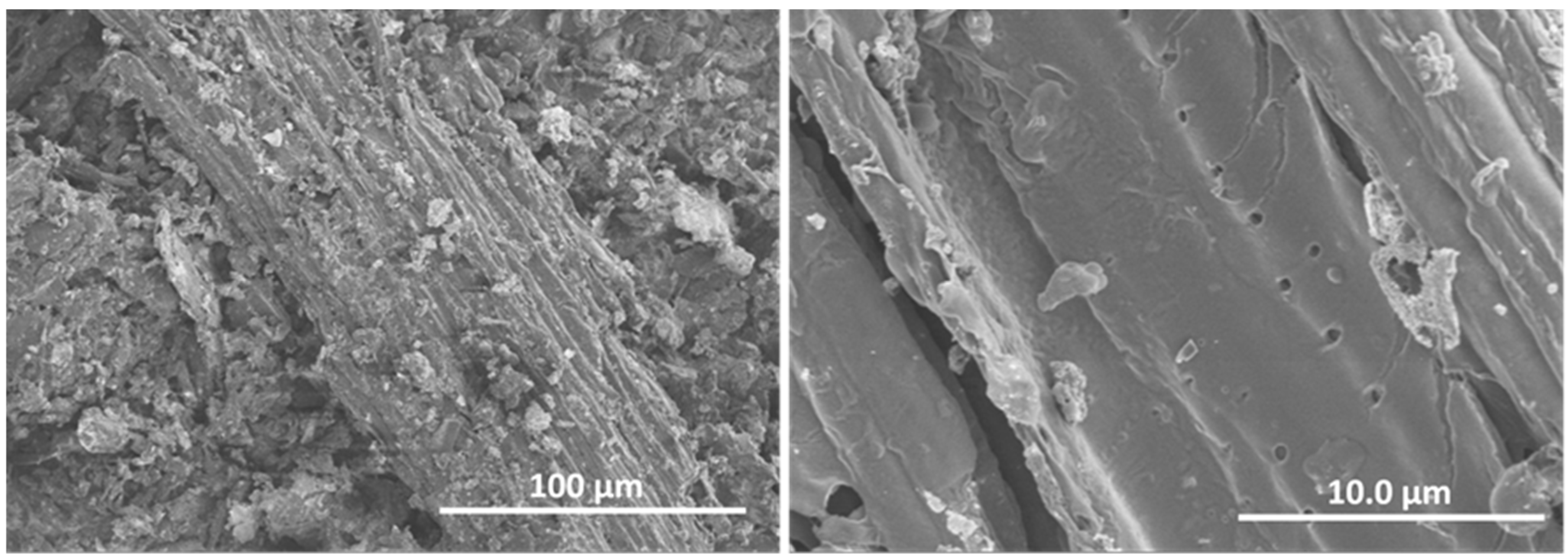
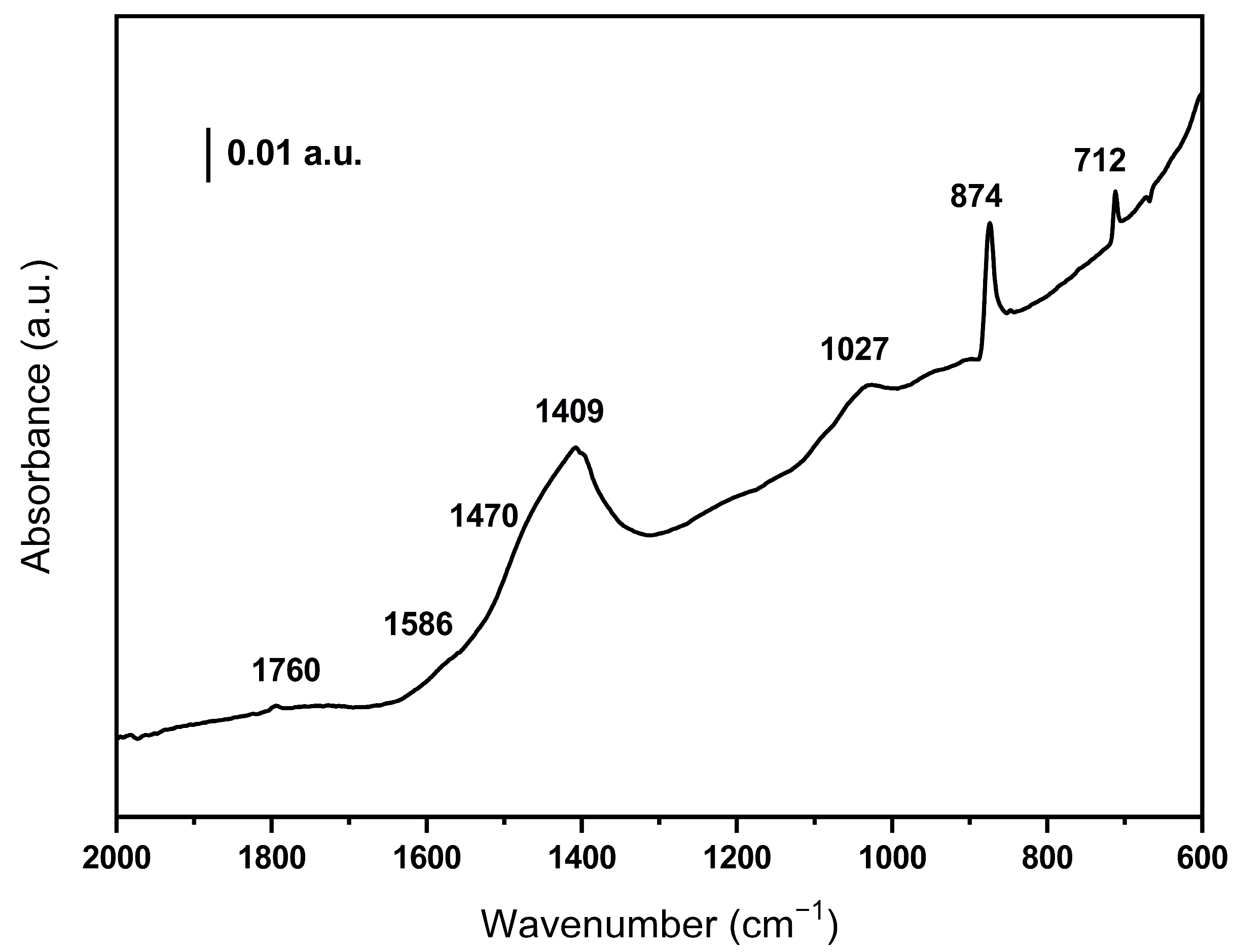
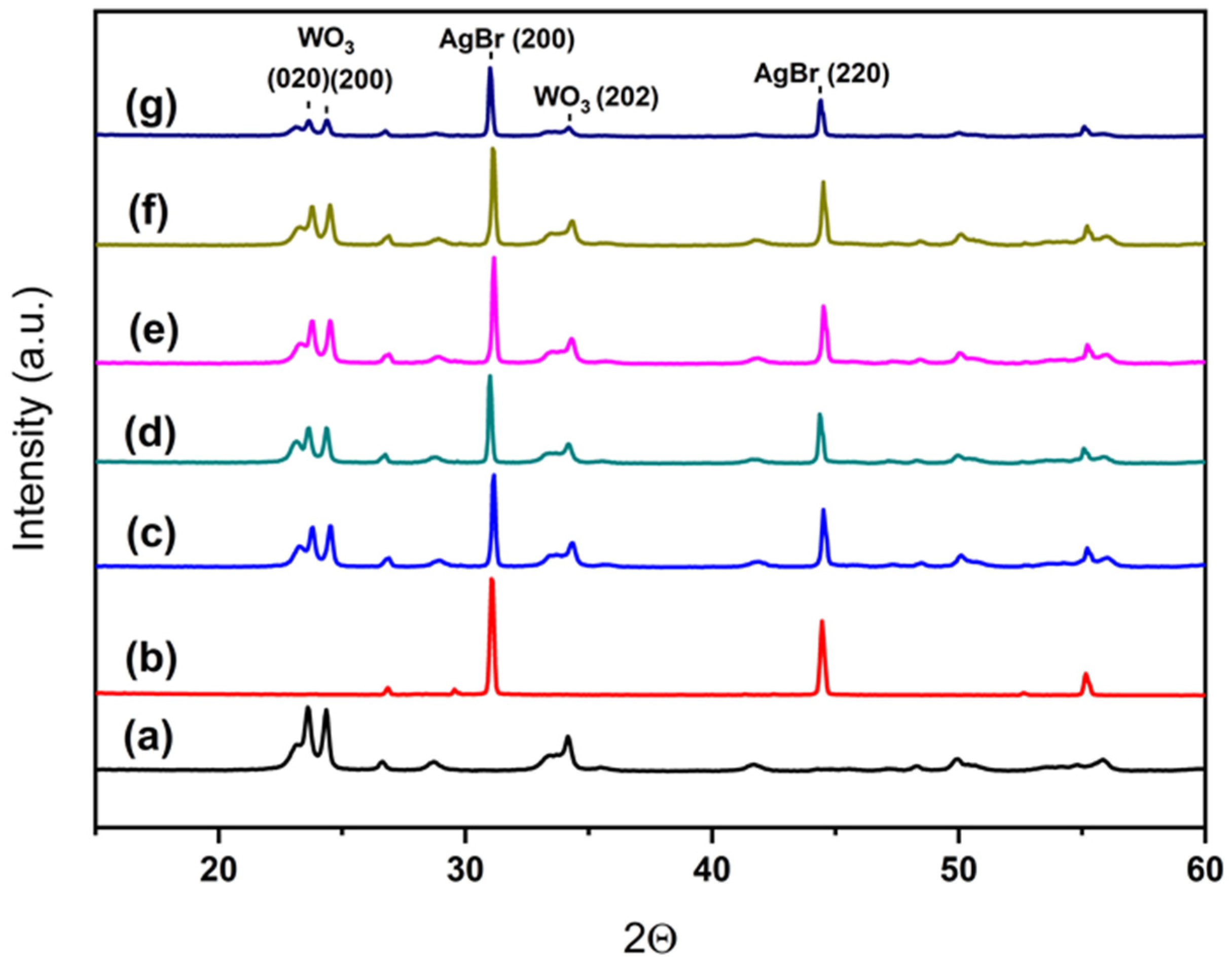

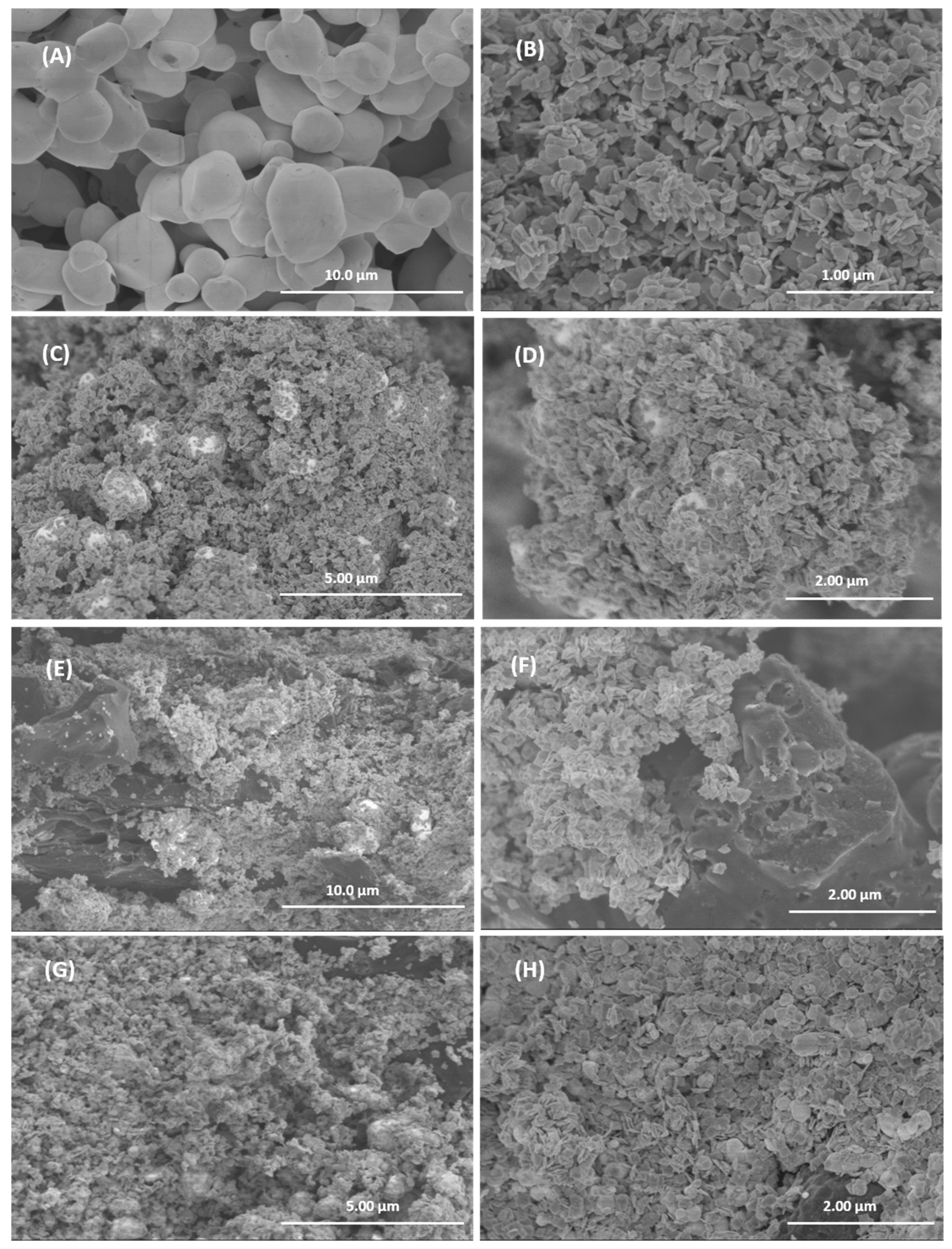
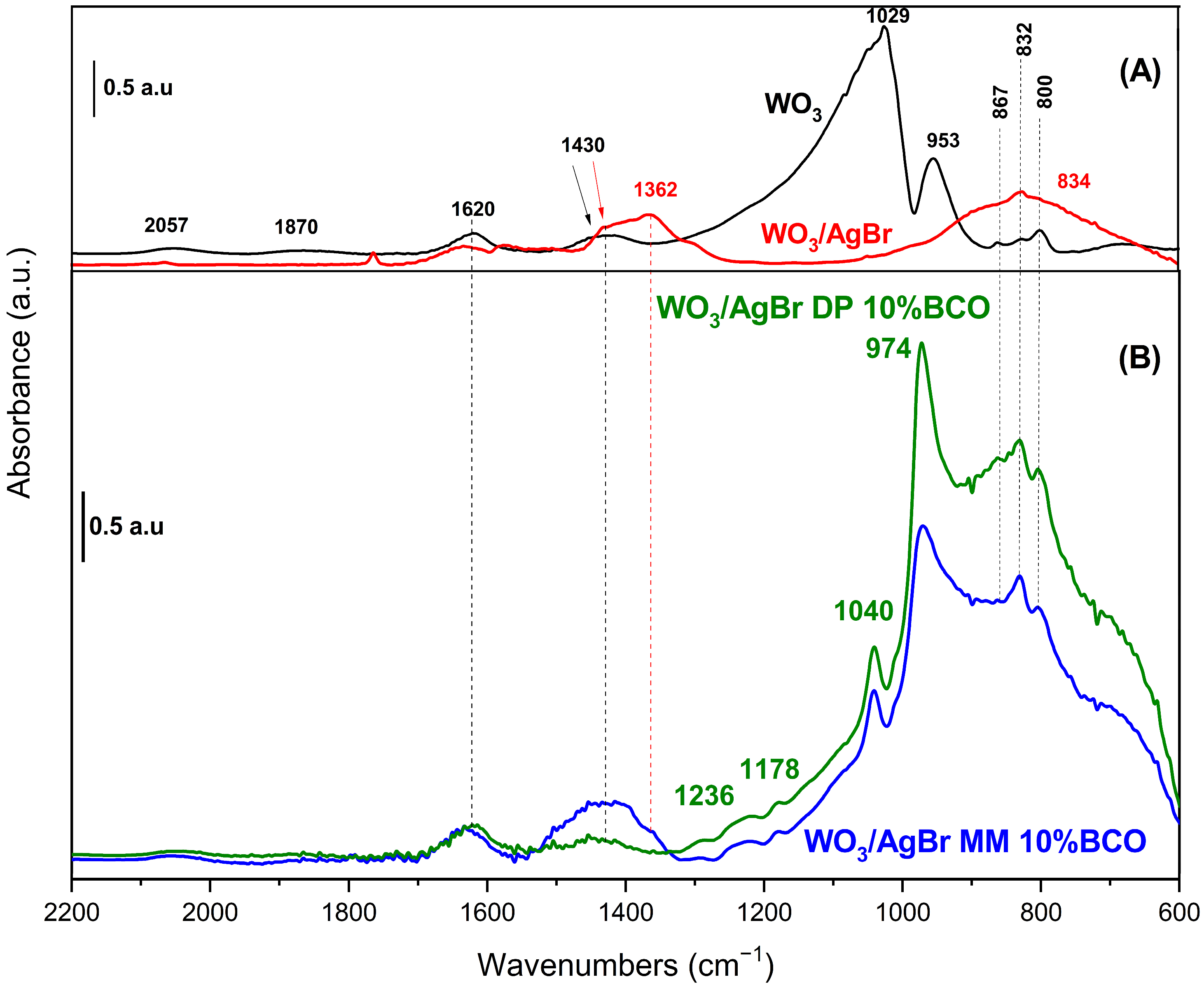
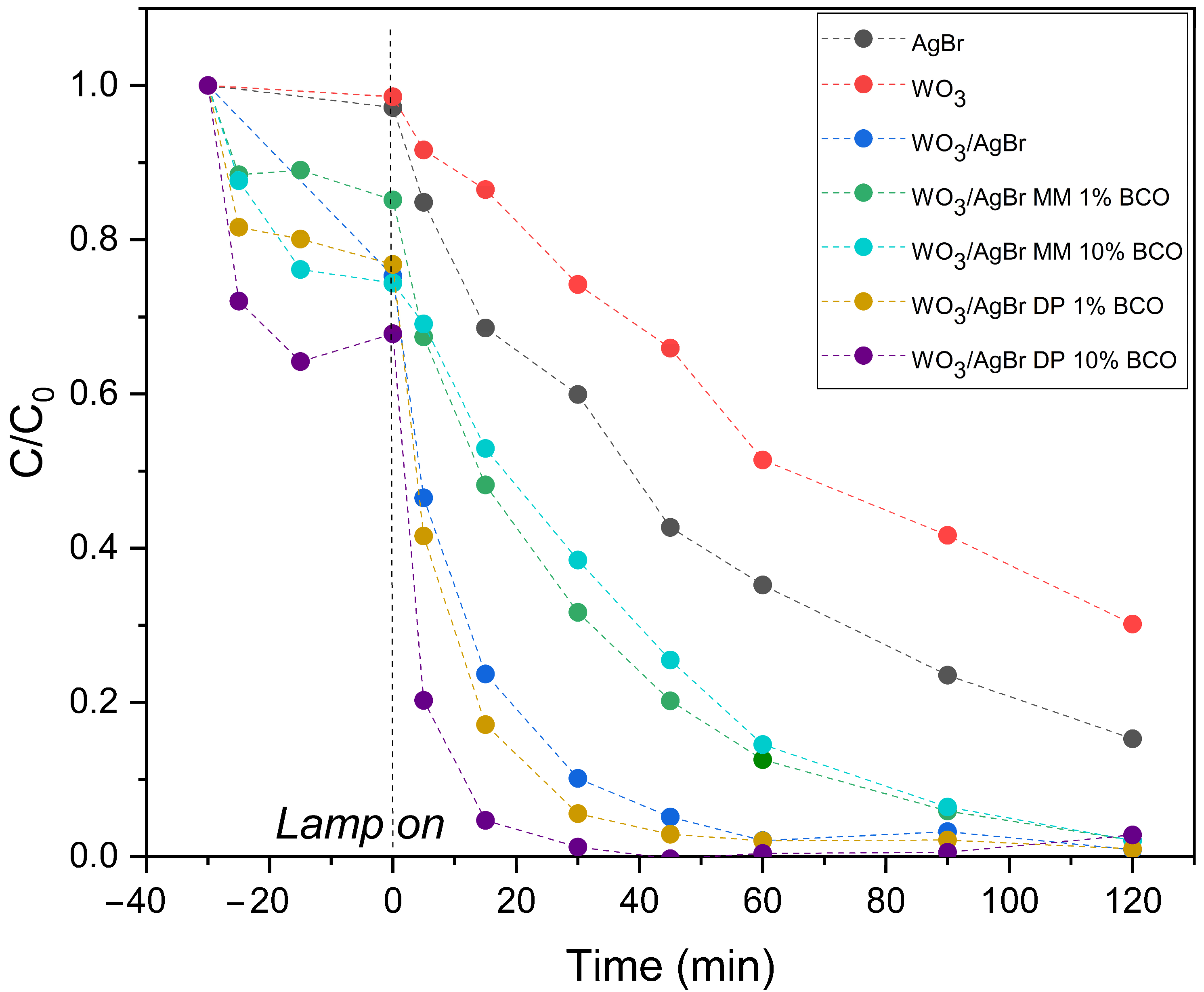
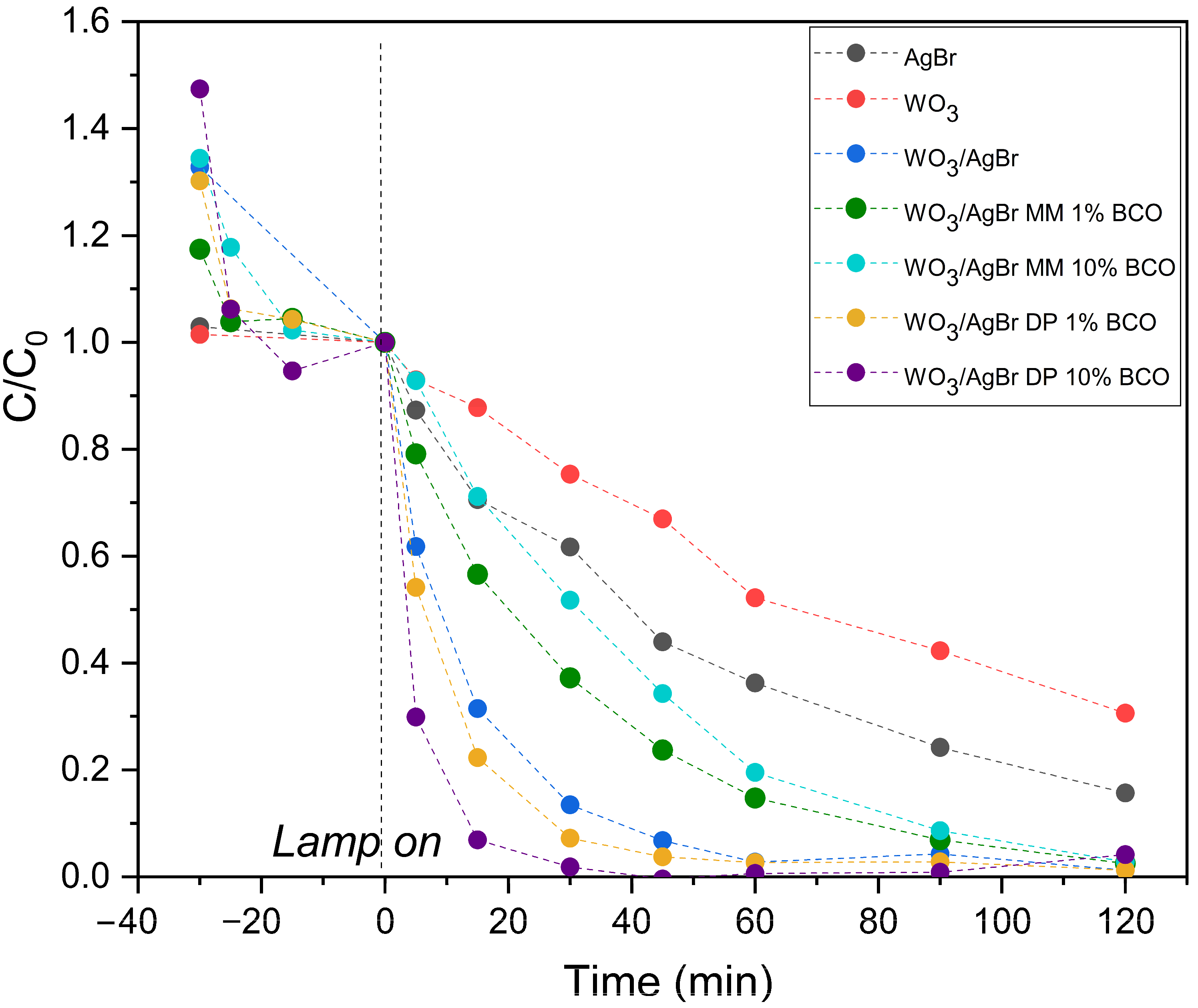
| Proximate Analysis (wt. %) | |
| Moisture | 7.75 |
| Volatiles | 82.3 |
| Ash | 4.37 |
| Ultimate Analysis (wt. %) | |
| C | 52.69 |
| H | 0.66 |
| N | 1.23 |
| O | 22.10 (*) |
| Elements | % (by Weight) * | Elements | % (by Weight) * |
|---|---|---|---|
| Al | 0.52 | Mg | 2.74 |
| Ca | 65.43 | Na | 0.32 |
| Cl | 0.24 | P | 2.32 |
| Cu | 0.17 | S | 0.65 |
| Fe | 1.00 | Si | 2.11 |
| K | 24.04 | Sr | 0.10 |
| Sample | SBET (m2/g) | Band Gap (eV) |
|---|---|---|
| BCO | 487 | - |
| AgBr | <1 | 2.66 |
| WO3 | 20 | 2.76 |
| WO3/AgBr | 9 | 2.65 |
| WO3/AgBr MM 1% BCO | 11 | 2.81 |
| WO3/AgBr MM 10% BCO | 38 | 2.71 |
| WO3/AgBr DP 1% BCO | 18 | 2.79 |
| WO3/AgBr DP 10% BCO | 37 | 2.80 |
| Catalysts | K (min−1) | R2 |
|---|---|---|
| AgBr | 0.015 | 0.994 |
| WO3 | 0.010 | 0.994 |
| WO3/AgBr | 0.058 | 0.993 |
| WO3/AgBr MM 1% BCO | 0.030 | 0.998 |
| WO3/AgBr MM 10% BCO | 0.030 | 0.993 |
| WO3/AgBr DP 1% BCO | 0.073 | 0.976 |
| WO3/AgBr DP 10% BCO | 0.127 | 0.963 |
Disclaimer/Publisher’s Note: The statements, opinions and data contained in all publications are solely those of the individual author(s) and contributor(s) and not of MDPI and/or the editor(s). MDPI and/or the editor(s) disclaim responsibility for any injury to people or property resulting from any ideas, methods, instructions or products referred to in the content. |
© 2025 by the authors. Licensee MDPI, Basel, Switzerland. This article is an open access article distributed under the terms and conditions of the Creative Commons Attribution (CC BY) license (https://creativecommons.org/licenses/by/4.0/).
Share and Cite
Hidalgo, M.C.; Alcalá, M.D.; Navío, J.A.; Romero-Sarria, F. Enhancing the Photocatalytic Performance of WO3/AgBr Composites Through the Incorporation of Olive Waste-Derived Biochar Obtained Under Controlled Pyrolysis Conditions. Int. J. Mol. Sci. 2025, 26, 10451. https://doi.org/10.3390/ijms262110451
Hidalgo MC, Alcalá MD, Navío JA, Romero-Sarria F. Enhancing the Photocatalytic Performance of WO3/AgBr Composites Through the Incorporation of Olive Waste-Derived Biochar Obtained Under Controlled Pyrolysis Conditions. International Journal of Molecular Sciences. 2025; 26(21):10451. https://doi.org/10.3390/ijms262110451
Chicago/Turabian StyleHidalgo, M. Carmen, María D. Alcalá, José A. Navío, and Francisca Romero-Sarria. 2025. "Enhancing the Photocatalytic Performance of WO3/AgBr Composites Through the Incorporation of Olive Waste-Derived Biochar Obtained Under Controlled Pyrolysis Conditions" International Journal of Molecular Sciences 26, no. 21: 10451. https://doi.org/10.3390/ijms262110451
APA StyleHidalgo, M. C., Alcalá, M. D., Navío, J. A., & Romero-Sarria, F. (2025). Enhancing the Photocatalytic Performance of WO3/AgBr Composites Through the Incorporation of Olive Waste-Derived Biochar Obtained Under Controlled Pyrolysis Conditions. International Journal of Molecular Sciences, 26(21), 10451. https://doi.org/10.3390/ijms262110451









